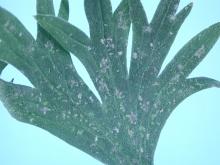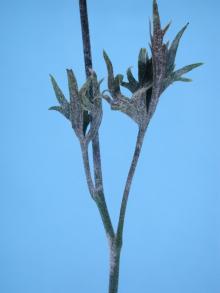Cause Several fungi such as Erysiphe spp. and Podosphaera spp. can cause powdery mildew but only Erysiphe polygoni and Golovinomyces cichoracearum (formerly Erysiphe cichoracearum) have been reported from the PNW. Conidia are released in response to abrupt decreases in relative humidity. Wind blows conidia to healthy foliage where they start new mildew colonies. Too much water, such as flowing water or rain, destroys spores by causing them to burst. The fungus does not grow in a leaf but rather across the surface. Small anchor cells of the fungus, haustoria, remain in the leaf and take nourishment from the plant, but the main filament and the multitudes of spores it produces are outside the leaf. The disease can develop under relatively dry conditions in spring and summer so long as the air is humid. Plants in shade tend to have more problems because that environment favors disease development. Multiple disease cycles occur during the growing season.
Symptoms White or grayish patches on leaves, stems and sometimes closed delphinium buds late in summer. Leaves turn yellow and die from the base of the stem up. Plant vigor and stem quality can be reduced. Curling and stunting of young leaves and growing tips occur when infections are severe.
Cultural control
- Avoid overcrowding plants.
- Use resistant cultivars such as Blue Bird, Cameliard, Galahad, and King Arthur.
- Destroy plant debris at the end of the season.
- Grow in well-drained, high pH soil and in full sun.
Chemical control Fungicides will do best when used before symptoms develop. Few materials have good eradicant activity. Use at 7- to 14-day intervals; using shorter intervals when environmental conditions favor disease development. Alternate or tank-mix products from different groups that have different modes of action. Limit the use of any one group during the growing season.
- Armada 50 WDG at 3 to 9 oz/100 gal water. Do not use a silicone-based surfactant. Not for nursery or greenhouse use. Group 3 + 11 fungicide. 12-hr reentry.
- Avelyo at 3 to 5 fl oz/100 gal water. Safe on larkspur. Group 3 fungicide. 12-hr reentry.
- Bicarbonate-based products. Might be used to supplement a normal program when powdery mildew is first observed. Do not mix with acidifying agents. Thorough coverage is essential. O
- MilStop (85% potassium bicarbonate) at 2.5 to 5 lb/A in the field or 1.25 to 5 lb/100 gal water in the greenhouse. Oregon and Washington only. 1-hr reentry.
- Monterey Bi-Carb Old Fashioned Fungicide at 4 teaspoons/2 gal water. H
- Compass 50 WDG at 1 to 2 oz/100 gal water. Do not use organosilicate additives. Group 11 fungicide. 12-hr reentry.
- Eagle 20 EW at 6 to 12 fl oz/100 gal water. Group 3 fungicide. 24-hr reentry.
- Myclobutanil 20 EW T&O at 6 to 12 fl oz/100 gal water plus spreading agent. May observe a PGR effect. Group 3 fungicide. 24-hr reentry.
- Ortho Rose & Flower Disease Control at 2 fl oz/gal water. Group 3 fungicide. H
- Propiconazole-based products. Group 3 fungicides.
- Banner MAXX at 5 to 8 fl oz/100 gal water. 12-hr reentry.
- Infuse Systemic Disease Control at 1 Tbsp/gal water. H
- Systemic Fungicide (ferti-lome) at 0.5 fl oz/gal water. H
- Safer Brand Garden Fungicide (Ready To Use 0.4% sulfur) thoroughly sprayed over the entire plant. Do not use when the temperature is over 85°F or within a few weeks of an oil spray. H
- Seido at 4 to 5 fl oz/100 gal water plus an adjuvant. Group 50 fungicide. 4-hr reentry.
- Spectracide Immunox Multi-Purpose Fungicide Spray Concentrate for Gardens at 1 fl oz/gal water. Group 3 fungicide. H
- Terraguard SC at 4 to 8 fl oz/100 gal water. Group 3 fungicide. 12-hr reentry.
- Thiolux (80% sulfur) at 3 to 10 lb/A. Group M2 fungicide. 24-hr reentry. O
- Ziram 76 DF at 1.5 to 2 lb/100 gal water. Although registered, this is not as effective as the other products. Group M3 fungicide. 48-hr reentry.
References Pirone, P.P. 1978. Diseases and Pests of Ornamental Plants, 5th ed. New York: John Wiley & Sons.
Wegulo, S.N., and Vilchez, M. 2008. Evaluation of delphinium cultivars for resistance to powdery mildew. HortTechnology 18:407-409.



